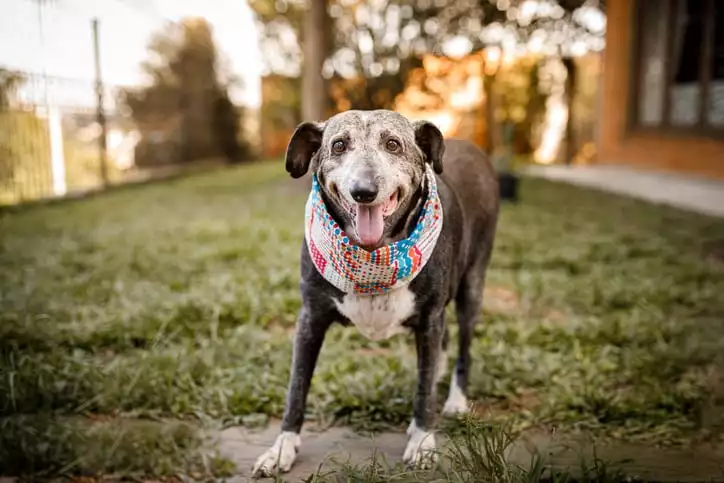According to the Journal of the American Animal Hospital Association (JAAHA), the term “senior” can describe an aging pet, but the number of years a pet is considered to be “senior” differs according to breed and size.
As the owner of a senior dog, you’ve probably noticed that your best friend is taking life a little easier. Senior dogs are generally less active than they used to be, and instead of bounding across the lawn after a ball or a stick, your best friend might lumber a bit slower, taking his time. A few years can make a big difference in a dog’s life, and many dog owners wonder at what age is a dog considered a senior? Comparing your human age to your furry friend’s canine age is rather complicated, and actually, one year to your dog is not equal to one year to you.
Want to know more about how to best help your senior dog? Book an appointment at Northern Pike Veterinary Hospital by calling 412-373-8580!
Calculating Your Dog’s Age
The most common theory comparing human and canine ages uses the equation “dog years x 7 = human years.” This has been a popular calculation, but quite exact. A more accurate comparison of human vs. dog age takes into consideration the dog’s size and breed. Smaller dogs age more slowly and have longer life spans. Larger dogs age more quickly and have shorter life spans. Also, certain breeds live longer than others. When comparing size, small Chihuahuas live longer than huge Saint Bernards, and Miniature Pinchers live longer than German Shepherds. But when comparing breeds, Bulldogs tend to live 8-10 years, and Cocker Spaniels 12-15 years. So it’s important to keep in mind that the 7 to 1 ratio doesn’t hold for every size and breed of dog.
Another factor that influences age calculation is the rate of canine development. Dogs develop more quickly in the first two years of life, and then growth levels out a bit. During the first two years, one dog year generally equals 10 1/2 human years. So in the young dog, the dog to human age ratio is 10.5:1, not 7:1. When a dog turns three, he ages 4 years to every 1 human year bringing the ratio to 4:1. So a two-year-old dog is equal to a 21-year-old human, and an 8-year-old dog is equal to a 45-year-old human. These formulas are based on the view that the average human life expectancy is 80 years old. But this formula doesn’t take into account size or breed.
So we know that 7 dog years = 1 human year theory is inaccurate because dogs develop fastest during the first two years of life. A more accurate estimate of a dog’s age in human years is calculated taking size and breed into consideration. This method either categorizes dogs as small, medium and large or more specifically uses their estimated adult weight. There is no definitive answer to calculate a dog’s age as compared to a human because there is too much variability across dog size and breeds. There are just so many breeds and so many sizes. However, what we do know is that dogs age more rapidly than humans do and that a one-year-old dog may resemble a gangly teenager who’s all legs, while an older 9-year dog may walk a bit more slowly and stiffly.
There is also the consideration of emotional maturity. Emotional maturity occurs over time, and just like we consider a 21-year-old human as an adult, but may not reach emotional maturity until age 40 or so. This same view applies to dogs. Even though a 9-month old puppy may be very active, that puppy isn’t considered an emotionally adult until age 3 or 4. Maybe that’s why 2-year-old Golden Retrievers still like to chew shoes!
Signs Your Dog is Aging
We know that dog senior status varies according to size and breed. Generally, small dogs are considered senior citizens when they reach 11 years of age, medium-sized dogs at 10 years of age, large breeds at 8 years of age, and giant-breeds at 7. So a Mastiff becomes a senior citizen much sooner than a miniature poodle. What are the signs that my dog is getting older?
Just as with humans, dogs exhibit many of the same issues, such as:
- Hearing loss
- Tooth loss
- Vision loss
- Loss of muscle tone
- Decreased energy
- Arthritis, and multiple joint issues
- Hair loss
- Drier and less elastic skin
- Reduced liver, kidney, and heart function
- “Senior” moments when mental acuity is reduced
- Reduced immune system
There is a wide range of factors to help you recognize signs of aging in your pet, and many of them are similar to the signs of aging in people. Some of these factors may be more obvious, like reduced activity or limited mobility.
Caring for a Senior Dog
There are some health considerations with senior pets, and a few are listed below:
Lumps and Bumps
Many dogs develop lumps and bumps while they age. Not every lump will need to be tested or removed, but monitoring them can avoid problems down the road. As with humans, lumps that grow or change can be possibly cancerous, so it’s best to have them checked by a veterinarian.
Eating Patterns and Weight
An older dog’s eating patterns and body weight can cause issues, and older dogs are less active so obesity can be an issue. Obesity in senior dogs can cause osteoarthritis and diabetes, and a too-thin animal or dog that won’t eat could be having dental or other health issues. Also, hypothyroidism (low thyroid function) can make older dogs feel lethargic and gain weight without eating more. It’s important to schedule regular check-ups with your veterinarian to make sure that your senior dog is healthy. You should also take into consideration lean muscle mass and body score.
Sleeping Patterns and Cognitive Health
Changes in sleeping patterns and cognitive behavior are also things to monitor. A dog who isn’t aware of his surroundings or has difficulty recognizing people may be experiencing some canine dementia.
Drinking Patterns and Urination
Senior dogs may tend to drink and urinate more frequently, and if you’re concerned about and your dog’s drinking patterns, contact your veterinarian, she may want to do some blood work and diagnostics to assess endocrine, liver, and kidney function.
Periodontal Disease
Periodontal disease is a common issue with senior dogs and can cause bad breath, inflamed gums, dental tartar, tooth loss, and abscesses. Left untreated, dental issues can impact a dog’s heart, kidneys, and other body systems. If you think that dental disease is causing discomfort for your dog, contact your veterinarian, and schedule an examination.
Kidney and Liver Disease
Kidney and liver disease can also be issues for older dogs, as well as cardiac disease, and it’s always a good idea to schedule regular check-ups for your older dog.
Cognitive Function
Senior dogs can also exhibit cognitive issues. Does your senior dog recognize family members? Is he aware of his surroundings? Declining cognitive function is a part of the aging process, and as it advances, it can disrupt aspects of your pet’s life.
Depression and Anxiety
Older pets can also experience depression, anxiety, and personality changes, and if you’re concerned, make an appointment with your veterinarian. Your veterinarian can prescribe medications that can help ease anxiety, and help with behavior modification.
Schedule Regular Exams with Your Veterinarian
Veterinarians recommend that senior dogs have regular examinations at least twice a year, and, it’s recommended that blood work, urine analysis, a full body examination, and other diagnostics be included in these check-ups. As a senior dog-owner, you can help your dog thrive in his autumn years by keeping him as comfortable as possible and keeping up-to-date on wellness exams with your veterinarian.
Call 412-373-8580 to book an exam for your senior dog with the veterinarians at Northern Pike Veterinary Hospital!


